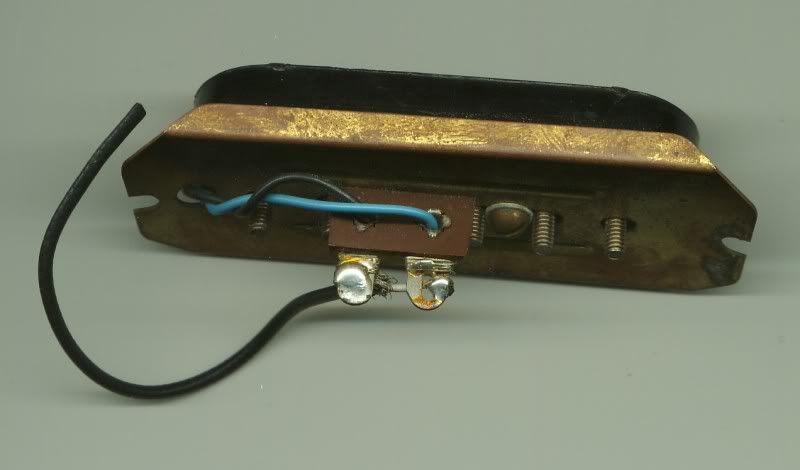die Bullen said:
I never knew you could adjust the pickup height at all- I thought all you could do are the pole pieces how do you do that?
This is what a Franz pickup looks like removed from the guitar (this is a slightly later one, on earlier ones the bobbin will look different, but the baseplate is the same, and that's what this is about)
It attaches to the body of the guitar with two very small screws that hook into the indentations you see on both short ends of the baseplate. Unlike a Gibson P90, these are not the same screws that hold the cover on - those are a separate set of screws, unrelated to the pickup.
To change the height of the pickup, you need to (carefully!) remove the pickup cover first. Can't stress "carefully" enough - sometimes, the covers shrink, and the polepieces get stuck in them. If you have the impression the fit for the polepieces is tight in the holes in the cover, remove the polepieces (by unscrewing them) first, cover second.
Once the cover is off, you can proceed to take the pickup out of the guitar by unscrewing the two screws that hold the pickup to the guitar's body.
Then, by very carefully and gently bending (with small pliers) the two short ends ("tabs") of the baseplate the pickup "sits" on, you can lower or raise the pickup quite a bit.
I've found this necessary to get good balance between them on all the dual-pickup Franz-equipped hollowbodies I've owned.
It's my experience that it's smart to start with the lead pickup, and get that to where you get optimum sound and output for your application, then proceed to the neck pickup, and balance that with what you're getting from the lead pickup.
On any guitar, but even more on full-hollowbodies, the neck position pickup is seeing more string energy, so with a pickup at a given distance, it will be louder than the lead pickup. If you start out with getting maximum sound and output from the neck pickup by adjusting it, you'll often find you ran out of adjustment range with the lead pickup, and it'll end up quieter and smaller sounding no matter how you adjust it.
As a general rule, getting the pickup body (as opposed to just the polepieces) closer to the strings will result in a stronger output, and a fatter, bigger tone. You can then adjust the string-to string balance with the individual polepieces. Not raising the pickup body, but just the poles, might make your pickup a little bit louder, but it will sound thinner and weaker than if you raise the coil closer to the strings.
There's are limits to "close to the strings" of course, the first one physical, dictated by the height of your pickup cover, but on my own guitars, I've found the Franz pickup covers to be plenty tall.
The second limit is - get the pickup too close to the strings, and it'll start sounding funny, and having too much output, to where it sounds blatty and will overdrive anything you plug it into.
No need to be afraid of magnetic string pull with Franz pickups like you would with typical Fender single coil pickups, or DeArmond pickups : the polescrews are steel, and the magnets are at a safe distance of the strings, under the coil.
If you're handy and not afraid to tinker with guitars, while you have the pickups out of the guitar, you might as well make them reverse wound/reverse polarity so the "both pickups on" middle switch setting is humcancelling. Some guitars already come like this by accident, most don't.
What you do for reversing the polarity on one of the pickups is :
-take out the screws that hold the coil to the baseplate. You find these on the underside of the baseplate.
-carefully slide out the magnets, remembering their orientation
-turn both magnets so that the narrow side that was facing the coil is now on the outside of the pickup -----> you want to just turn them 180°, keeping the top side top. You don't want to reverse them so the top side become the under side.
You can reassemble the pickup now.
-With the magnets reversed, on one pickup, it will now be out of phase with the other one, and sound funny. To fix that, you need to reverse the wires coming out of the coil, going into that metal tab you see in the pic. (the tab that the guitar's wiring harness connects to inside the guitar). This step, of course, requires a soldering iron. If you're doing all this with the pickups still connected to the guitar's harness -
cover your guitar with a rag or two - you don't want to drip hot solder on your precious old Guild!!!
-if you've done these steps right, you now have a pickup set that will be humcancelling with both pickups selected.
Sorry for the long-winded post.
